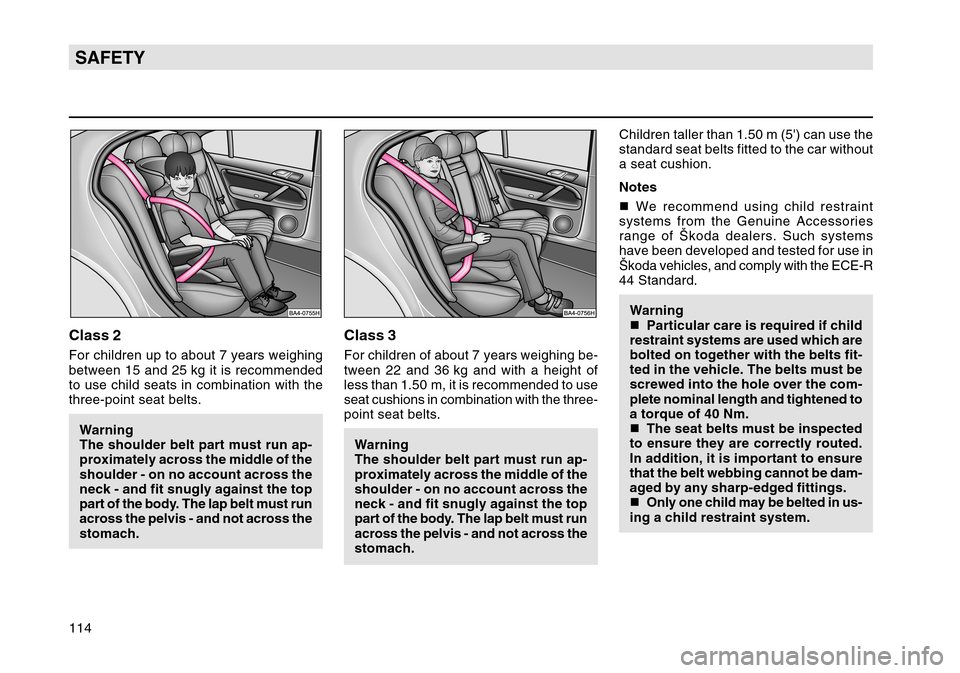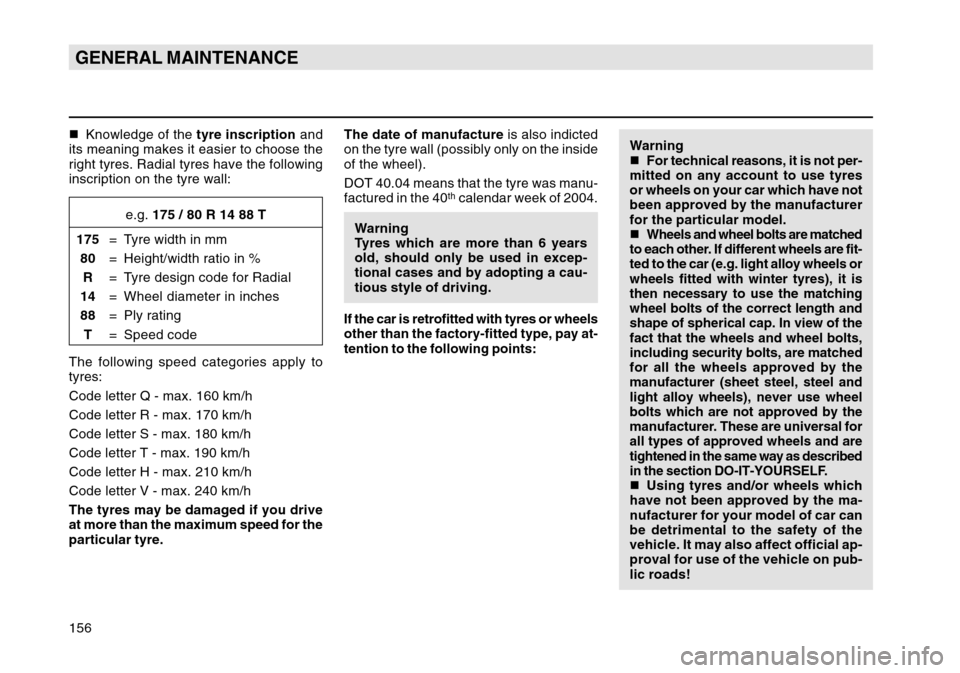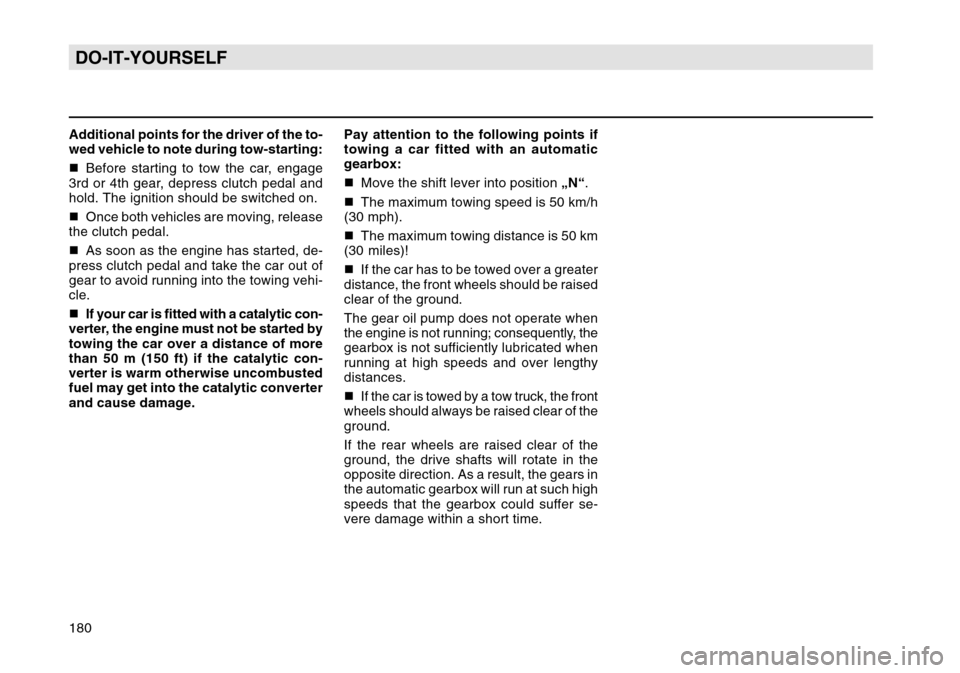Page 115 of 189

114SAFETYClass 2For children up to about 7 years weighing
between 15 and 25 kg it is recommended
to use child seats in combination with the
three-point seat belts.Warning
The shoulder belt part must run ap-
proximately across the middle of the
shoulder - on no account across the
neck - and fit snugly against the top
part of the body. The lap belt must run
across the pelvis - and not across the
stomach.
Class 3For children of about 7 years weighing be-
tween 22 and 36 kg and with a height of
less than 1.50 m, it is recommended to use
seat cushions in combination with the three-
point seat belts.Warning
The shoulder belt part must run ap-
proximately across the middle of the
shoulder - on no account across the
neck - and fit snugly against the top
part of the body. The lap belt must run
across the pelvis - and not across the
stomach. Children taller than 1.50 m (5') can use the
standard seat belts fitted to the car without
a seat cushion.
Notes
�
We recommend using child restraint
systems from the Genuine Accessories
range of Škoda dealers. Such systems
have been developed and tested for use in
Škoda vehicles, and comply with the ECE-R
44 Standard.
Warning
� Particular care is required if child
restraint systems are used which are
bolted on together with the belts fit-
ted in the vehicle. The belts must be
screwed into the hole over the com-
plete nominal length and tightened to
a torque of 40 Nm.
� The seat belts must be inspected
to ensure they are correctly routed.
In addition, it is important to ensure
that the belt webbing cannot be dam-
aged by any sharp-edged fittings.
� Only one child may be belted in us-
ing a child restraint system.
Page 157 of 189

156GENERAL MAINTENANCE�Knowledge of the tyre inscription and
its meaning makes it easier to choose the
right tyres. Radial tyres have the following
inscription on the tyre wall:
e.g. 175 / 80 R 14 88 T
175 = Tyre width in mm
80 = Height/width ratio in %
R = Tyre design code for Radial
14 = Wheel diameter in inches
88 = Ply rating
T = Speed code
The following speed categories apply to
tyres:
Code letter Q - max. 160 km/h
Code letter R - max. 170 km/h
Code letter S - max. 180 km/h
Code letter T - max. 190 km/h
Code letter H - max. 210 km/h
Code letter V - max. 240 km/h
The tyres may be damaged if you drive
at more than the maximum speed for the
particular tyre.
The date of manufacture is also indicted
on the tyre wall (possibly only on the inside
of the wheel).
DOT 40.04 means that the tyre was manu-
factured in the 40
th calendar week of 2004.
Warning
Tyres which are more than 6 years
old, should only be used in excep-
tional cases and by adopting a cau-
tious style of driving.
If the car is retrofitted with tyres or wheels
other than the factory-fitted type, pay at-
tention to the following points:
Warning
� For technical reasons, it is not per-
mitted on any account to use tyres
or wheels on your car which have not
been approved by the manufacturer
for the particular model.
�
Wheels and wheel bolts are matched
to each other. If different wheels are fit-
ted to the car (e.g. light alloy wheels or
wheels fitted with winter tyres), it is
then necessary to use the matching
wheel bolts of the correct length and
shape of spherical cap. In view of the
fact that the wheels and wheel bolts,
including security bolts, are matched
for all the wheels approved by the
manufacturer (sheet steel, steel and
light alloy wheels), never use wheel
bolts which are not approved by the
manufacturer. These are universal for
all types of approved wheels and are
tightened in the same way as described
in the section DO-IT-YOURSELF.
� Using tyres and/or wheels which
have not been approved by the ma-
nufacturer for your model of car can
be detrimental to the safety of the
vehicle. It may also affect official ap-
proval for use of the vehicle on pub-
lic roads!
Page 181 of 189

180DO-IT-YOURSELFAdditional points for the driver of the to-
wed vehicle to note during tow-starting:
�Before starting to tow the car, engage
3rd or 4th gear, depress clutch pedal and
hold. The ignition should be switched on.
� Once both vehicles are moving, release
the clutch pedal.
� As soon as the engine has started, de-
press clutch pedal and take the car out of
gear to avoid running into the towing vehi-
cle.
� If your car is fitted with a catalytic con-
verter, the engine must not be started by
towing the car over a distance of more
than 50 m (150 ft) if the catalytic con-
verter is warm otherwise uncombusted
fuel may get into the catalytic converter
and cause damage. Pay attention to the following points if
towing a car fitted with an automatic
gearbox:
�
Move the shift lever into position „N“.
� The maximum towing speed is 50 km/h
(30 mph).
� The maximum towing distance is 50 km
(30 miles)!
� If the car has to be towed over a greater
distance, the front wheels should be raised
clear of the ground.
The gear oil pump does not operate when
the engine is not running; consequently, the
gearbox is not sufficiently lubricated when
running at high speeds and over lengthy
distances.
� If the car is towed by a tow truck, the front
wheels should always be raised clear of the
ground.
If the rear wheels are raised clear of the
ground, the drive shafts will rotate in the
opposite direction. As a result, the gears in
the automatic gearbox will run at such high
speeds that the gearbox could suffer se-
vere damage within a short time.